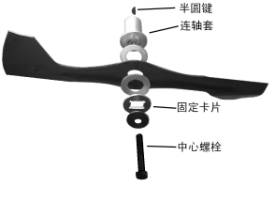Lawnmower Maintenance Schedule WB20ZB7 and WB450A models |
|---|
|
FILL IN DATES |
BEFORE EACH USE |
AFTER EACH USE |
EVERY 10 HOURS |
EVERY 25HOURS OR EVERY SEASON |
BEFORE STORAGE |
SERVICE DATES |
|
M |
Check for loose fasteners |
√ |
|
|
|
√ |
|
Clean/Inspect Grass Catcher (If Equipped) |
√ |
√ |
|
|
√ |
|
|
Clean Lawnmower |
|
√ |
|
|
√ |
|
|
Clean Under Drive Cover (Power-Propelled Mowers) |
|
|
√4 |
|
|
|
|
Check/Sharpen/Replace Blade |
|
|
|
√3 |
|
|
|
Lubrication Chart |
|
|
|
√ |
√ |
|
|
E |
Check Engine Oil Level |
√ |
|
|
|
|
|
Change Engine Oil |
|
|
|
√1、2 |
|
|
|
Clean Air Filter |
|
|
|
√2 |
|
|
|
Inspect Muffler |
|
|
|
√ |
|
|
|
Clean or replace Spark Plug |
|
|
|
√ |
|
|
|
Replace Air Filter Paper Cartridge |
|
|
|
√ |
|
|
|
GENERAL RECOMMENDATIONS
The warranty on this lawn mower does not cover items that have been subjected to operator abuse or negligence. To receive full value from the warranty, operator must maintain mower as instructed in this manual.
Some adjustments will need to be made periodically to properly maintain your unit.
All adjustments in the Service and Adjustments section of this manual should be checked at least once each season.
WARNING:MAKE SURE DOING ALL OPERATIONS WHEN THE ENGINE STOPPED.
BEFORE EACH USE
LUBRICATION
Keep unit well lubricated(See“LUBRICATION CHART”)
LAWN MOWER
Always observe safety rules when performing any maintenance.
TIRE
·Keep tires free of gasoline, oil, or insect control chemicals which can harm rubber.
·Avoid stumps, stones, deep ruts, sharp objects and other hazards that may cause tire damage.
BLADE CARE
For best results, mower blade must be kept sharp. Replace bent or damaged blades.
TO REMOVE BLADE
NOTE: Remove the blade adapter and check the key inside hub of blade adapter. The key must be in good condition to work properly. Replace adapter if damaged.
TO REPLACE BLADE:
IMPORTANT: BLADE BOLT IS GRADE 10.9 HEAT TREATED.

TO SHARPEN BLADE
NOTE: We do not recommend sharpening blade-but if you do, be sure the blade is balanced.
Care should be taken to keep the blade balanced. An unbalanced blade will cause eventual damage to lawn mower or engine.
·The blade can be sharpened with a file or on a grinding wheel. Do not attempt to sharpen while on the mower.
·To check blade balance, drive a nail into a beam or wall. Leave about one inch of the straight nail exposed. Place center hole of blade over the head of the nail. If blade is balanced, it should remain in a horizontal position. If either end of the blade moves downward, sharpen the heavy end until the blade is balanced.
GRASS CATCHER
·The grass catcher may be hosed with water, but must be dry when used.
·Check your grass catcher often for damage or deterioration. Through normal use it will wear. If catcher needs replacing, replace only with a manufacturer approved replacement catcher. Give the lawn mower model number when ordering.
DRIVE WHEELS
Check rear drive wheels each time you mow to be sure they move freely. The wheels not turning freely means trash, grass cuttings, etc. may be inside the drive wheel and dust cover area and must be cleaned out to free drive wheels.
If necessary to clean the drive wheels, check both rear wheels.
NOTE: The pinion gear, on both sides of the mower, are the same, however, they must be installed correctly. If installed incorrectly, the drive system will not work.
ENGINE
Read the Maintenance section of your engine manual.
LUBRICATION
Use only high quality detergent oil rated with API service classification SF-SJ. Select the oil’s SAE viscosity grade according to your expected operating temperature.
NOTE: Although multi-viscosity oils (5W30,10W30 etc) improve starting in cold weather, these multi-viscosity oils will result in increased oil consumption when used above 32°F. Check your engine oil level more frequently to avoid possible engine damage from running low on oil.
Change the oil after every 25hours of operation or at least once a year if the lawn mower is not used for 25hours in one year.
Check the crankcase oil level before starting the engine and after each five (5) hours of continuous use. Tighten oil plug securely each time you check the oil level.
TO CHANGE ENGINE OIL
NOTE: Before tipping lawn mower to drain oil, drain fuel tank by running engine until fuel tank is empty.
AIR FILTER
Your engine will not run properly and may be damaged by using a dirty air filter. Clean the element after every 25hours of operation, more often if lawn mower is used in very dusty, dirty conditions.
See the maintenance section of your engine manual.
MUFFLER
Inspect and replace corroded muffler as it could create a fire hazard and/or damage.
SPARK PLUG
Change your spark plug each year to make your engine start easier and run better. Set spark plug gap at.030 inch.
CLEAMING
IMPORTANT: FOR BEST PERFORMANCE, KEEP MOWER HOUSING FREE OF BUILT-UP GRASS&TRASH. CLEAN THE UNDERSIDE OF YOUR MOWER AFTER EACH USE.
CAUTION: Disconnect spark plug wire from spark plug and place wire where it cannot come in contact with spark plug.